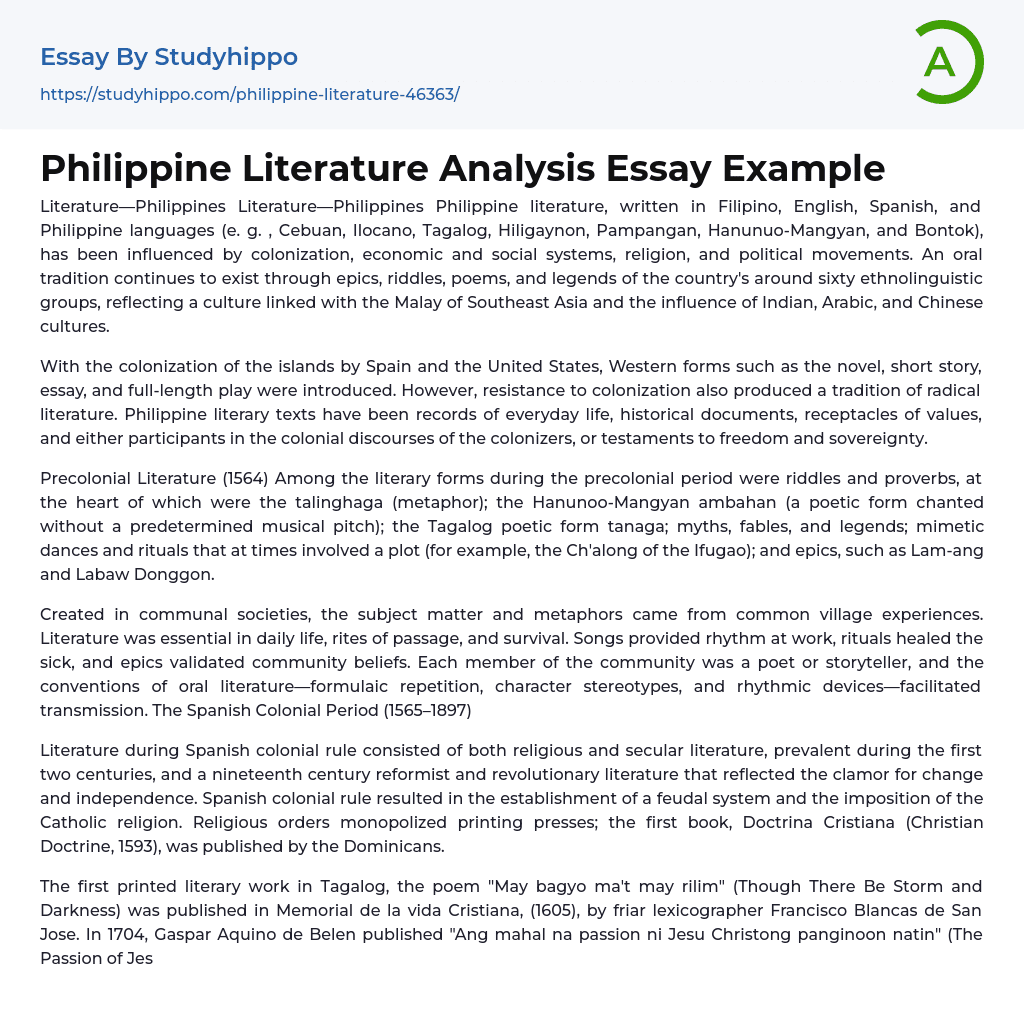Philippine literature, which is written in Filipino, English, Spanish, and various Philippine languages (Cebuan, Ilocano, Tagalog, Hiligaynon, Pampangan, Hanunuo-Mangyan, and Bontok), has been shaped by colonization, economic and social structures, religion, and political movements. Despite these influences, an oral tradition still persists in the form of epics, riddles, poems, and legends among the approximately sixty ethnolinguistic groups in the country. This reflects a cultural connection to the Malay of Southeast Asia as well as the impact of Indian, Arabic, and Chinese cultures.
The islands were colonized by both Spain and the United States, resulting in the introduction of Western literary forms such as novels, short stories, essays, and full-length plays. However, resistance to colonization also gave rise to a tradition of radical literature in the Philippines. Literary texts from the Philippines serve as records of daily life, historica
...l documents, holders of values, and either participants in the colonizers' colonial discussions or statements of freedom and independence.
During the precolonial period, various literary forms emerged, including riddles, proverbs, and poetic forms like talinghaga, ambahan, and tanaga. Additionally, myths, fables, legends, mimetic dances, and rituals also played a significant role. Examples of precolonial epics include Lam-ang and Labaw Donggon.
The subject matter and metaphors in literature during the Spanish Colonial Period (1565–1897) originated from common village experiences in communal societies. It played a vital role in daily life, rites of passage, and survival. Songs were used for rhythmic work, rituals were performed for healing the sick, and epic narratives were shared to validate community beliefs. Everyone in the community was considered a poet or storyteller, and the conventions of oral literature, such as formulaic repetition,
character stereotypes, and rhythmic devices, were used to facilitate transmission.
During the Spanish colonial era, literature comprised both religious and secular works. These two types of literature were prominent in the first two centuries, along with reformist and revolutionary literature that emerged in the nineteenth century, reflecting the desire for change and independence. Spanish colonial rule also brought about a feudal system and the Catholic religion was enforced. The printing presses were controlled by religious orders, and the first book to be published, Doctrina Cristiana (Christian Doctrine, 1593), was released by the Dominicans.
The first printed literary work in Tagalog, called "May bagyo ma't may rilim" (Though There Be Storm and Darkness), was published in Memorial de la vida Cristiana (1605) by Francisco Blancas de San Jose, a friar lexicographer. In 1704, Gaspar Aquino de Belen published "Ang mahal na passion ni Jesu Christong panginoon natin" (The Passion of Jesus Christ Our Lord), a narrative poem about the life of Christ. The dominant literature at the time focused on affirming religious values and included forms like the sinakulo, a play about the passion of Christ, the ejemplo, which discussed saints, and the komedya, which depicted battles between Christians and Moors.
Nationalist literary historians argue that the feudal and colonial discourses in the Philippines played a role in its colonization. These discourses propagated various beliefs and values such as submission to one's fate, obedience to authority, the superiority of the colonizers, and the dominance of Catholicism over Islam. Moreover, Spanish ballads, which served as inspirations for the komedya, also influenced narrative poetry like the awit, characterized by its four monohasloo. com http://hasloo. com/philippine-online-encyclopedia Powered by Joomla!
align="justify">
Generated: 22 July, 2009, 12:38 - The awit, a form of Filipino poetry, is characterized by its rhyming dodecasyllabic lines. Another popular form is the korido, which consists of four mono-rhyming octosyllabic lines. One of the most notable awits is "Pinagdaanang buhay ni Florante at Laura sa cahariang Albania" (The Life of Florante and Laura in Albania, 1838), written by Francisco Baltazar (1788–1862). This literary work holds great significance as the first nationalist text in the country, known for its criticism of colonial rule as well as its popularity and skilled use of language.
The emergence of nationalist consciousness led to the creation of literature advocating for change. These works were authored by ilustrados, who were Filipino students in Spain. Many of these literary pieces either mocked religious literature or introduced fresh literary forms to effectively express various issues. Marcelo H. del Pilar, in his poem "Friar Ginoong Barya" (Hail Father Coins), criticized religious orders by using the pasyon and prayers, and depicted the friar as a monetary currency. This poem was a parody of the popular prayer "Aba Ginoong Maria" (Hail Mary).
- Book Summary essays
- Metaphor essays
- Reader essays
- Rhyme essays
- Literary devices essays
- Villain essays
- Books essays
- Genre essays
- Literary Criticism essays
- Writer essays
- Protagonist essays
- Simile essays
- Poem essays
- Book Report essays
- Book Review essays
- Greek Mythology essays
- Plot essays
- Tragic Hero essays
- Coming of Age essays
- Play essays
- Rhetoric essays
- Rhetorical Question essays
- Translation essays
- Understanding essays
- Reason essays
- Character essays
- Letter essays
- American Literature essays
- Literature Review essays
- Utopia essays
- Poetry Analysis essays
- Dante's Inferno essays
- Between The World and Me essays
- Incidents in The Life of a Slave Girl essays
- Flowers for Algernon essays
- Myth essays
- Everyday Use essays
- Boo Radley essays
- Genesis essays
- Richard iii essays
- Alice in Wonderland essays
- On the road essays
- Ozymandias essays
- The Nightingale essays
- Holden Caulfield essays
- Animal Farm essays
- 1984 essays
- A Hanging essays
- Shooting An Elephant essays
- A Tale Of Two Cities essays


Unfortunately copying the content is not possible
Tell us your email address and we’ll send this sample there.
By continuing, you agree to our Terms and Conditions.


